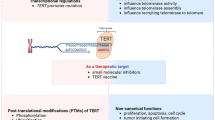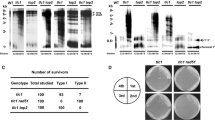Abstract
TERC is the RNA component of telomerase, and provides a template for TERT to synthesize telomere repeats at chromosome ends. Increasing evidence has revealed that TERC is involved in other biological processes beyond telomerase. Here, we found that the expression level of TERC is negatively correlated with PD-L1 and that ectopic expression of TERC but not TERT in ALT cells significantly inhibits PD-L1, suggesting that TERC suppresses PD-L1 expression in a telomerase-independent manner. Mechanistically, instead of regulating PD-L1 mRNA directly, TERC accelerates PD-L1 mRNA degradation by inhibiting the expression of HuR, which binds to the 3′UTR of PD-L1 mRNA and maintains its stability. We also found that the small molecule AS1842856, a FoxO1 inhibitor, promotes TERC expression and reverses the PD-L1 upregulation caused by chemotherapy, providing a potential combination cancer therapy that avoids cancer immune escape during chemotherapy.
Similar content being viewed by others
References
Astakhova, A.A., Chistyakov, D.V., Sergeeva, M.G., and Reiser, G. (2018). Regulation of the ARE-binding proteins, TTP (tristetraprolin) and HuR (human antigen R), in inflammatory response in astrocytes. Neurochem Int 118, 82–90.
Barnhart, M.D., Moon, S.L., Emch, A.W., Wilusz, C.J., and Wilusz, J. (2013). Changes in cellular mRNA stability, splicing, and polyadenylation through HuR protein sequestration by a cytoplasmic RNA virus. Cell Rep 5, 909–917.
Blank, C., and Mackensen, A. (2007). Contribution of the PD-L1/PD-1 pathway to T-cell exhaustion: an update on implications for chronic infections and tumor evasion. Cancer Immunol Immunother 56, 739–745.
Blasco, M.A., Rizen, M., Greider, C.W., and Hanahan, D. (1996). Differential regulation of telomerase activity and telomerase RNA during multi-stage tumorigenesis. Nat Genet 12, 200–204.
Brennan, C.M., and Steitz, J.A. (2001). HuR and mRNA stability. CMLS Cell Mol Life Sci 58, 266–277.
Bryan, T.M., Englezou, A., Gupta, J., Bacchetti, S., and Reddel, R.R. (1995). Telomere elongation in immortal human cells without detectable telomerase activity. EMBO J 14, 4240–4248.
Chu, C., Qu, K., Zhong, F.L., Artandi, S.E., and Chang, H.Y. (2011). Genomic maps of long noncoding RNA occupancy reveal principles of RNA-chromatin interactions. Mol Cell 44, 667–678.
Coelho, M.A., de Carné Trécesson, S., Rana, S., Zecchin, D., Moore, C., Molina-Arcas, M., East, P., Spencer-Dene, B., Nye, E., Barnouin, K., et al. (2017). Oncogenic RAS signaling promotes tumor immunoresistance by stabilizing PD-L1 mRNA. Immunity 47, 1083–1099.e6.
Feng, J., Funk, W.D., Wang, S.S., Weinrich, S.L., Avilion, A.A., Chiu, C.P., Adams, R.R., Chang, E., Allsopp, R.C., Yu, J., et al. (1995). The RNA component of human telomerase. Science 269, 1236–1241.
Gagliardi, M., and Matarazzo, M.R. (2016). RIP: RNA Immunoprecipitation. In: Lanzuolo, C., and Bodega, B., eds. Polycomb Group Proteins. Methods in Molecular Biology. New York: Humana Press. 73–86.
Gao, Q., Wang, X.Y., Qiu, S.J., Yamato, I., Sho, M., Nakajima, Y., Zhou, J., Li, B.Z., Shi, Y.H., Xiao, Y.S., et al. (2009). Overexpression of PD-L1 significantly associates with tumor aggressiveness and postoperative recurrence in human hepatocellular carcinoma. Clin Cancer Res 15, 971–979.
Gazzaniga, F.S., and Blackburn, E.H. (2014). An antiapoptotic role for telomerase RNA in human immune cells independent of telomere integrity or telomerase enzymatic activity. Blood 124, 3675–3684.
Hamanishi, J., Mandai, M., Iwasaki, M., Okazaki, T., Tanaka, Y., Yamaguchi, K., Higuchi, T., Yagi, H., Takakura, K., Minato, N., et al. (2007). Programmed cell death 1 ligand 1 and tumor-infiltrating CD8 T lymphocytes are prognostic factors of human ovarian cancer. Proc Natl Acad Sci USA 104, 3360–3365.
Hinman, M.N., and Lou, H. (2008). Diverse molecular functions of Hu proteins. Cell Mol Life Sci 65, 3168–3181.
Hsiang, Y.H., Hertzberg, R., Hecht, S., and Liu, L.F. (1985). Camptothecin induces protein-linked DNA breaks via mammalian DNA topoisomerase I. J Biol Chem 260, 14873–14878.
Huang, J., Zhang, A., Ho, T.T., Zhang, Z., Zhou, N., Ding, X., Zhang, X., Xu, M., and Mo, Y.Y. (2016). Linc-RoR promotes c-Myc expression through hnRNP I and AUF1. Nucleic Acids Res 44, 3059–3069.
Ivanyi-Nagy, R., Ahmed, S.M., Peter, S., Ramani, P.D., Ong, P.F., Dreesen, O., and Dröge, P. (2018). The RNA interactome of human telomerase RNA reveals a coding-independent role for a histone mRNA in telomere homeostasis. elife 7, e40037.
Keir, M.E., Butte, M.J., Freeman, G.J., and Sharpe, A.H. (2008). PD-1 and its ligands in tolerance and immunity. Annu Rev Immunol 26, 677–704.
Lebedeva, S., Jens, M., Theil, K., Schwanhäusser, B., Selbach, M., Landthaler, M., and Rajewsky, N. (2011). Transcriptome-wide analysis of regulatory interactions of the RNA-binding protein HuR. Mol Cell 43, 340–352.
Li, X., Shao, C., Shi, Y., and Han, W. (2018). Lessons learned from the blockade of immune checkpoints in cancer immunotherapy. J Hematol Oncol 11, 31.
Liu, H., Yang, Y., Ge, Y., Liu, J., and Zhao, Y. (2019). TERC promotes cellular inflammatory response independent of telomerase. Nucleic Acids Res 47, 8084–8095.
Long, Y., Wang, X., Youmans, D.T., and Cech, T.R. (2017). How do lncRNAs regulate transcription? Sci Adv 3, eaao2110.
Mayr, C. (2017). Regulation by 3′-untranslated regions. Annu Rev Genet 51, 171–194.
Meller, V.H., Joshi, S.S., and Deshpande, N. (2015). Modulation of chromatin by noncoding RNA. Annu Rev Genet 49, 673–695.
Nagashima, T., Shigematsu, N., Maruki, R., Urano, Y., Tanaka, H., Shimaya, A., Shimokawa, T., and Shibasaki, M. (2010). Discovery of novel forkhead box O1 inhibitors for treating type 2 diabetes: improvement of fasting glycemia in diabetic db/db mice. Mol Pharmacol 78, 961–970.
Pardoll, D.M. (2012). The blockade of immune checkpoints in cancer immunotherapy. Nat Rev Cancer 12, 252–264.
Pascolo, E., Wenz, C., Lingner, J., Hauel, N., Priepke, H., Kauffmann, I., Garin-Chesa, P., Rettig, W.J., Damm, K., and Schnapp, A. (2002). Mechanism of human telomerase inhibition by BIBR1532, a synthetic, non-nucleosidic drug candidate. J Biol Chem 277, 15566–15572.
Peggs, K.S., Quezada, S.A., and Allison, J.P. (2008). Cell intrinsic mechanisms of T-cell inhibition and application to cancer therapy. Immunol Rev 224, 141–165.
Peng, W.X., Koirala, P., and Mo, Y.Y. (2017). LncRNA-mediated regulation of cell signaling in cancer. Oncogene 36, 5661–5667.
Sato, H., Niimi, A., Yasuhara, T., Permata, T.B.M., Hagiwara, Y., Isono, M., Nuryadi, E., Sekine, R., Oike, T., Kakoti, S., et al. (2017). DNA double-strand break repair pathway regulates PD-L1 expression in cancer cells. Nat Commun 8, 1751.
Sharpe, A.H., Wherry, E.J., Ahmed, R., and Freeman, G.J. (2007). The function of programmed cell death 1 and its ligands in regulating autoimmunity and infection. Nat Immunol 8, 239–245.
Shay, J.W., and Wright, W.E. (2011). Role of telomeres and telomerase in cancer. Semin Cancer Biol 21, 349–353.
Sun, C., Mezzadra, R., and Schumacher, T.N. (2018). Regulation and function of the PD-L1 checkpoint. Immunity 48, 434–452.
Sun, S., Zhang, X., Lyu, L., Li, X., Yao, S., and Zhang, J. (2016). Autotaxin expression is regulated at the post-transcriptional level by the RNA-binding proteins HuR and AUF1. J Biol Chem 291, 25823–25836.
Sznol, M., and Chen, L. (2013). Antagonist antibodies to PD-1 and B7-H1 (PD-L1) in the treatment of advanced human cancer. Clin Cancer Res 19, 1021–1034.
Tamura, T., Ohira, M., Tanaka, H., Muguruma, K., Toyokawa, T., Kubo, N., Sakurai, K., Amano, R., Kimura, K., Shibutani, M., et al. (2015). Programmed death-1 ligand-1 (PDL1) expression is associated with the prognosis of patients with stage II/III gastric cancer. Anticancer Res 35, 5369–5376.
Ting, N.S.Y., Pohorelic, B., Yu, Y., Lees-Miller, S.P., and Beattie, T.L. (2009). The human telomerase RNA component, hTR, activates the DNA-dependent protein kinase to phosphorylate heterogeneous nuclear ribonucleoprotein A1. Nucleic Acids Res 37, 6105–6115.
Wang, J., Guo, Y., Chu, H., Guan, Y., Bi, J., and Wang, B. (2013). Multiple functions of the RNA-binding protein HuR in cancer progression, treatment responses and prognosis. Int J Mol Sci 14, 10015–10041.
Wang, K.C., and Chang, H.Y. (2011). Molecular mechanisms of long noncoding RNAs. Mol Cell 43, 904–914.
Xia, L., Wang, H., Sun, M., Yang, Y., Yao, C., He, S., Duan, H., Xia, W., Sun, R., Yao, Y., et al. (2021). Peripheral CD4+ T cell signatures in predicting the responses to anti-PD-1/PD-L1 monotherapy for Chinese advanced non-small cell lung cancer. Sci China Life Sci 64, 1590–1601.
Yang, Y., Yu, Y., and Lu, S. (2020). Effectiveness of PD-1/PD-L1 inhibitors in the treatment of lung cancer: Brightness and challenge. Sci China Life Sci 63, 1499–1514.
Wu, S., Ge, Y., Lin, K., Liu, Q., Zhou, H., Hu, Q., Zhao, Y., He, W., and Ju, Z. (2022). Telomerase RNA TERC and the PI3K-AKT pathway form a positive feedback loop to regulate cell proliferation independent of telomerase activity. Nucleic Acids Res 50, 3764–3776.
Yao, R.W., Wang, Y., and Chen, L.L. (2019). Cellular functions of long noncoding RNAs. Nat Cell Biol 21, 542–551.
Yi, X., Tesmer, V.M., Savre-Train, I., Shay, J.W., and Wright, W.E. (1999). Both transcriptional and posttranscriptional mechanisms regulate human telomerase template RNA levels. Mol Cell Biol 19, 3989–3997.
Yoon, J.H., Abdelmohsen, K., Srikantan, S., Yang, X., Martindale, J.L., De, S., Huarte, M., Zhan, M., Becker, K.G., and Gorospe, M. (2012). LincRNA-p21 suppresses target mRNA translation. Mol Cell 47, 648–655.
Zhai, W., Zhou, X., Zhai, M., Li, W., Ran, Y., Sun, Y., Du, J., Zhao, W., Xing, L., Qi, Y., et al. (2021). Blocking of the PD-1/PD-L1 interaction by a novel cyclic peptide inhibitor for cancer immunotherapy. Sci China Life Sci 64, 548–562.
Zhang, J.M., and Zou, L. (2020). Alternative lengthening of telomeres: from molecular mechanisms to therapeutic outlooks. Cell Biosci 10, 30.
Zhao, Y., Liu, Y., Lin, L., Huang, Q., He, W., Zhang, S., Dong, S., Wen, Z., Rao, J., Liao, W., et al. (2018). The lncRNA MACC1-AS1 promotes gastric cancer cell metabolic plasticity via AMPK/Lin28 mediated mRNA stability of MACC1. Mol Cancer 17, 69.
Zhuang, R., Rao, J.N., Zou, T., Liu, L., Xiao, L., Cao, S., Hansraj, N.Z., Gorospe, M., and Wang, J.Y. (2013). miR-195 competes with HuR to modulate stim1 mRNA stability and regulate cell migration. Nucleic Acids Res 41, 7905–7919.
Zou, T., Mazan-Mamczarz, K., Rao, J.N., Liu, L., Marasa, B.S., Zhang, A. H., Xiao, L., Pullmann, R., Gorospe, M., and Wang, J.Y. (2006). Polyamine depletion increases cytoplasmic levels of RNA-binding protein HuR leading to stabilization of nucleophosmin and p53 mRNAs. J Biol Chem 281, 19387–19394.
Acknowledgements
This work was supported by the National Natural Science Foundation of China (31970683, 82171549), Guangdong Basic and Applied Basic Research Foundation (2021A1515010848).
Author information
Authors and Affiliations
Corresponding author
Additional information
Compliance and ethics
The author(s) declare that they have no conflict of interest.
Rights and permissions
About this article
Cite this article
Jin, H., Chen, Y., Ren, J. et al. TERC suppresses PD-L1 expression by downregulating RNA binding protein HuR. Sci. China Life Sci. 65, 2505–2516 (2022). https://doi.org/10.1007/s11427-021-2085-9
Received:
Accepted:
Published:
Issue Date:
DOI: https://doi.org/10.1007/s11427-021-2085-9




